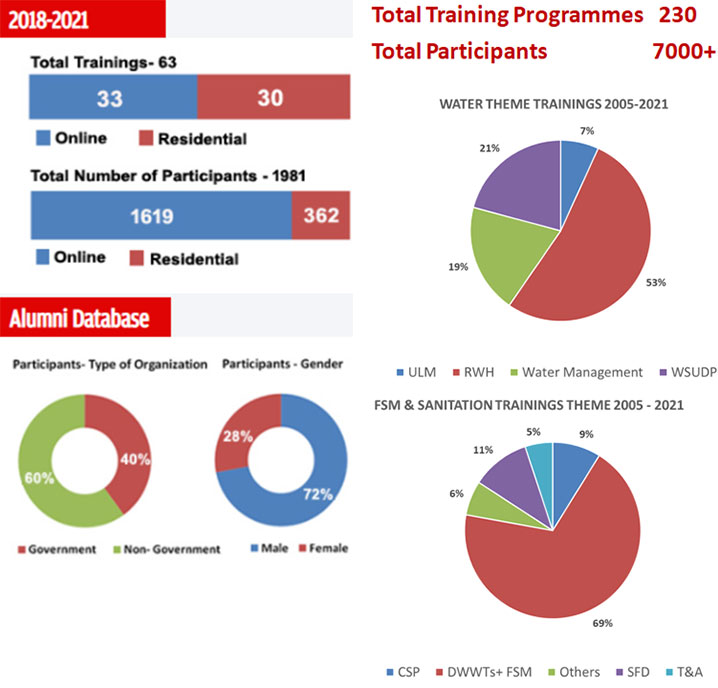It is a registered society under the Ministry of Jal Shakti, Government of India, to take measures for prevention, control and abatement of environmental pollution in Ganga and to ensure continuous and adequate flow of water so as to rejuvenate, protect and manage the river.
Centre for Science and Environment(CSE) has been an important thought-leader in the water management sector. It has already influenced global policies and strategies to focus on the need for technologies to augment water resources in a decentralized manner through rainwater harvesting and to use that water to optimize benefits. Programme interventions are designed to help build institutional and technical capacities of key agencies and practitioners required for mainstreaming sustainable and affordable water and sanitation management.
Several publications by CSE that laid the reform agenda for water management in the country include Dying Wisdom (1997) documenting the rise, fall and potential of India’s traditional water harvesting systems from different ecological contexts; Making Water Everybody’s Business (2001), connecting the theory and practice of RWH; Catch Water Where it Falls, targeting planners and policy makers with a toolkit; and Sewage Canal—How to Clean the Yamuna, a focused research report highlighting the need for re-engineering water and sewage management to address river pollution.
A documentary titled Faecal Attraction led to a national debate on the National River Conservation Plan and CSE is actively involved in the revamping of the plan.
In 2017, CSE published the first Practitioner's Guide in India, demonstrating Green Infrastructure as one of the solutions to overcome the emerging water management issues of water supply and quality regulation and moderation of extreme flood events. In the same year, CSE also came up with another Practitioner’s Guide on Water-sensitive urban design and planning (WSUDP). WSUDP approach helps in integrating the urban water cycle, water supply, wastewater, stormwater and groundwater management with spatial and urban design. Another publication, Water Efficiency and Conservation: A Practitioner’s Guide, deals with mainstream water efficiency and conservation (WEC) from policy to practice. It provides guidance with regard to practicing WEC for effective planning of water-secure cities at the city and smaller scales.
The centre has also set up a helpdesk to provide technical support to municipal functionaries and other non-state actors for planning, designing and implementing best management practices in the area of sustainable water and wastewater management. A few such examples are the RWH structure at the Rashtrapati Bhawan, and the decentralized wastewater treatment system implemented at the headquarters of the Delhi Jal Board (New Delhi), Nehru Garden (Alwar, Rajasthan), Ganga Prem Hospice (Uttarakhand) and A.K. Garg Engineering College (Ghaziabad, Uttar Pradesh).


The School of Water and Waste (SWW) was set up as part of the Anil Agarwal Environment Training Institute in order to facilitate such capacity building. The school offers interdisciplinary, double-loop and cross-country learning tailored to the ground reality of the major problems of the water supply and sanitation sector in the urban landscape. Since SWW operationalization, 30 residential trainings have been conducted for 362 participants, in addition to 33 online courses for 1,619 participants and several webinars to promote sustainable water management. Trainings at SWW focus on the following themes (these also include trainings in collaboration with institutions like World Health Organization, Cooperative Research Centre for Water Sensitive Cities, International Water Association and School of Planning and Architecture, Delhi):
- Nature-based solutions for water and waste management
- Effective faecal sludge and septage management
- Mainstreaming citywide sanitation
- Tools and approaches for citywide water and sanitation management
- Water sensitive urban design and planning at building and neighborhood scale
- Urban wetlands management
- Sanitation safety planning
- Water speaks: Effective communication for advocacy, influence and impact
- Water woes: Understanding urban water management and sustainability
- Mainstreaming water–energy nexus in the wake of climate change
- Faecal sludge and decentralized wastewater management
- Citywide inclusive sanitation
Capacity building of around 500 municipal functionaries and trainers from other ‘centres of excellence’ assisting the ministry has also been organized through several short-term training programmes and national exposure visits.
This initiative has been developed under a partnership between CSE and NMCG for capacity building for making cities in the Ganga basin water-sensitive and improving the river flow and health.
Capacity building of ULBs has been one of the important components identified in the integrated Namami Gange programme and the World Bank-assisted Ganga II programme. This component is critical, considering that it aims at behavioural changes in the ULB officials including representatives for creating an enabling environment and for addressing challenges in implementation of Namami Gange programme.
The proposal is to sensitize and build capacities of 1300+ functionaries (of ULBs, state and Centre, including NMCG),among them elected representatives and other key actors.